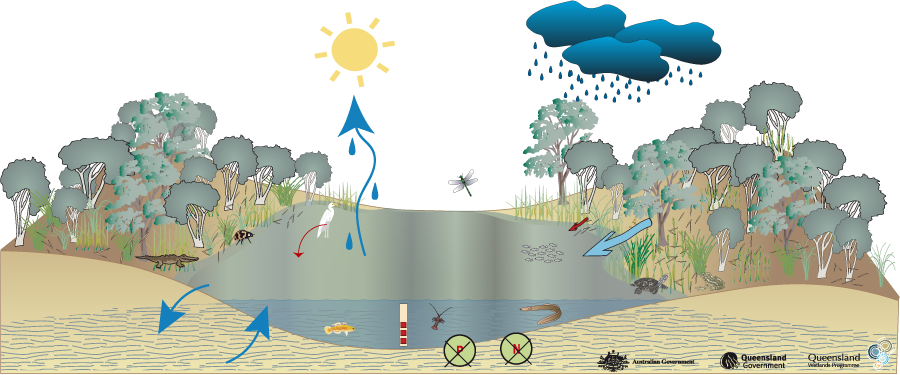|
|
Coastal and subcoastal non-floodplain sand lake—WindowCoastal and subcoastal non-floodplain sand lake—Window – Locations Click on elements of the model or select from the tabs below Coastal dune lakes are non-tidal, freshwater wetlands that occur in siliceous sands along coastal dune areas of eastern Queensland. From the tip of Cape York to the New South Wales border, there are hundreds of freshwater lakes. Most of these occur in high rainfall areas and are oriented with their long axis aligned in a south-east to north-west direction, in line with prevailing winds. Perhaps the most well-known coastal dune lakes are those on Fraser Island in south-east Queensland. Fraser Island contains over 40 perched dune lakes (for example Lakes Birrabeen, Allom, McKenzie, Bowarrady and Benaroon). In fact, half of the world’s perched dune lakes occur here. Lake Boomanjin on Fraser Island is recognised as the world’s largest perched lake. In the South East Queensland bioregion, coastal dune lakes are also found on Moreton Island (for example Blue Lagoon and Lake Jabiru), Stradbroke Island (such as Blue Lake, Brown Lake and Tortoise Lagoon) and within the Cooloola sandmass (for example Poona, Freshwater and Deepwater Lakes). Further north, coastal dune lakes and swamp wetlands are found in the Dismal Swamp section of the Shoalwater Bay dunefield area/Shoalwater Bay Military Training Area (near Byfield) of the Central Queensland Coast bioregion (bioregion 8). This area is recognised for its diverse landscape and vegetation types, and relatively undisturbed wilderness areas. The tropical dunefields on Cape York Peninsula bioregion also contain numerous dune lakes and wetland habitats. These are similar both biologically and chemically to the dune lakes of south-east Queensland. However, unlike south-east Queensland dune lakes, which are situated on deep sand dunes, those in the Cape York Peninsula bioregion are associated with ancient dunes that are thinly covered with sand and have basement rocks (laterite and Mesozoic sandstones) close to the surface. Last updated: 22 March 2013 This page should be cited as: Department of Environment, Science and Innovation, Queensland (2013) Coastal and subcoastal non-floodplain sand lake—Window – Locations, WetlandInfo website, accessed 8 May 2025. Available at: https://wetlandinfo.des.qld.gov.au/wetlands/ecology/aquatic-ecosystems-natural/lacustrine/non-floodplain-sand-lake/location.html |

 — Department of the Environment, Tourism, Science and Innovation
— Department of the Environment, Tourism, Science and Innovation

